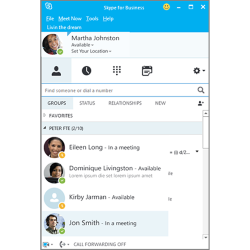

That’s a fairly big change, but an exciting one. “we see this as something that is going to be supported in our core MCUs, the MCUs that are handling the media processing will get core native WebRTC support, so you’ll be able to talk to those MCUs directly” (I’m looking at the new Mac client)Īnother interesting comment, whilst talking about Microsoft’s commitment to the WebRTC working group was around how WebRTC support won’t be just a “bolt-on” but: However, it could also mean that WebRTC will become the standard media provider for some Skype for Business first-party applications, especially (presumably) those built on top of UCWA.

It could just mean that WebRTC support will come to the Skype Web Access experience, which makes sense.

“The ability for us to support this (WebRTC) in the core meeting experience is definitely on the roadmap and something that you will see over time” Hinting at some of the reasons for the delay he said: However, it’s worth noting that the actual run-time implementation of how your code works in each browser will be different, so you should still test in each browser you plan to support.Īndrew also said some interesting things about where else we might see WebRTC in the rest of the Skype for Business ecosystem over time. Having a common abstraction means that developers won’t be have to rewrite their applications each time a WebRTC implementation changes. This is a Good Thing, because WebRTC can be hard to implement, is likely to change over time, and every browser supports it differently. This same abstracting will be used for WebRTC support. This is the model in use today to provide either plugin-less ORTC support in Edge, or plugin support with other browsers.

This common provider will allow developers to write code without having to choose or know ahead of time which browsers are in use, or even which codecs or technologies are supported. WebRTC support is still being worked on, but it’s not quite ready yet.Īs described before, the implementation route that Microsoft are chosing is to abstract the detail of media sharing from the end-developer but using a Common Media Provider. At that time Microsoft announced that they would also be supporting WebRTC but didn’t give any more details. This is because Edge natively supports oRTC (and has done since around September last year). The state of play today is that you can use the Edge browser without requiring a plug-in and conduct audio and video calls with the Skype Web SDK, but other browsers require a plug-in. At Microsoft Ignite 2016, as part of a talk (watch it at the bottom of this page) given by Andrew Bybee, Principal GPM on the Skype Developer Platform we received an update to what’s happening with WebRTC in the Skype Web SDK.


 0 kommentar(er)
0 kommentar(er)
